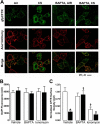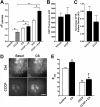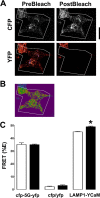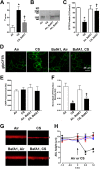Cigarette smoke-induced Ca2+ release leads to cystic fibrosis transmembrane conductance regulator (CFTR) dysfunction
- PMID: 24448802
- PMCID: PMC3953278
- DOI: 10.1074/jbc.M113.545137
Cigarette smoke-induced Ca2+ release leads to cystic fibrosis transmembrane conductance regulator (CFTR) dysfunction
Abstract
Chronic obstructive pulmonary disease affects 64 million people and is currently the fourth leading cause of death worldwide. Chronic obstructive pulmonary disease includes both emphysema and chronic bronchitis, and in the case of chronic bronchitis represents an inflammatory response of the airways that is associated with mucus hypersecretion and obstruction of small airways. Recently, it has emerged that exposure to cigarette smoke (CS) leads to an inhibition of the cystic fibrosis transmembrane conductance regulator (CFTR) Cl(-) channel, causing airway surface liquid dehydration, which may play a role in the development of chronic bronchitis. CS rapidly clears CFTR from the plasma membrane and causes it to be deposited into aggresome-like compartments. However, little is known about the mechanism(s) responsible for the internalization of CFTR following CS exposure. Our studies revealed that CS triggered a rise in cytoplasmic Ca(2+) that may have emanated from lysosomes. Furthermore, chelation of cytoplasmic Ca(2+), but not inhibition of protein kinases/phosphatases, prevented CS-induced CFTR internalization. The macrolide antibiotic bafilomycin A1 inhibited CS-induced Ca(2+) release and prevented CFTR clearance from the plasma membrane, further linking cytoplasmic Ca(2+) and CFTR internalization. We hypothesize that CS-induced Ca(2+) release prevents normal sorting/degradation of CFTR and causes internalized CFTR to reroute to aggresomes. Our data provide mechanistic insight into the potentially deleterious effects of CS on airway epithelia and outline a hitherto unrecognized signaling event triggered by CS that may affect the long term transition of the lung into a hyper-inflammatory/dehydrated environment.
Keywords: Chronic Obstructive Pulmonary Disease (COPD); Cystic Fibrosis; Epithelium; Ion Channels; Lysosomes.
Figures







Similar articles
-
Cigarette smoke exposure induces CFTR internalization and insolubility, leading to airway surface liquid dehydration.FASEB J. 2012 Feb;26(2):533-45. doi: 10.1096/fj.11-192377. Epub 2011 Oct 11. FASEB J. 2012. PMID: 21990373 Free PMC article.
-
Augmentation of S-Nitrosoglutathione Controls Cigarette Smoke-Induced Inflammatory-Oxidative Stress and Chronic Obstructive Pulmonary Disease-Emphysema Pathogenesis by Restoring Cystic Fibrosis Transmembrane Conductance Regulator Function.Antioxid Redox Signal. 2017 Sep 1;27(7):433-451. doi: 10.1089/ars.2016.6895. Epub 2017 Feb 7. Antioxid Redox Signal. 2017. PMID: 28006950 Free PMC article.
-
Therapeutic strategies to reverse cigarette smoke-induced ion channel and mucociliary dysfunction in COPD airway epithelial cells.Am J Physiol Lung Cell Mol Physiol. 2025 Apr 1;328(4):L571-L585. doi: 10.1152/ajplung.00258.2024. Epub 2025 Mar 17. Am J Physiol Lung Cell Mol Physiol. 2025. PMID: 40095970 Free PMC article.
-
Cystic Fibrosis Transmembrane Conductance Regulator. Implications in Cystic Fibrosis and Chronic Obstructive Pulmonary Disease.Ann Am Thorac Soc. 2016 Apr;13 Suppl 2:S150-5. doi: 10.1513/AnnalsATS.201509-588KV. Ann Am Thorac Soc. 2016. PMID: 27115950 Review.
-
Cigarette Smoke-Induced Acquired Dysfunction of Cystic Fibrosis Transmembrane Conductance Regulator in the Pathogenesis of Chronic Obstructive Pulmonary Disease.Oxid Med Cell Longev. 2018 Apr 23;2018:6567578. doi: 10.1155/2018/6567578. eCollection 2018. Oxid Med Cell Longev. 2018. PMID: 29849907 Free PMC article. Review.
Cited by
-
Airway Epithelium Dysfunction in Cystic Fibrosis and COPD.Mediators Inflamm. 2018 Apr 8;2018:1309746. doi: 10.1155/2018/1309746. eCollection 2018. Mediators Inflamm. 2018. PMID: 29849481 Free PMC article. Review.
-
JUUL e-liquid exposure elicits cytoplasmic Ca2+ responses and leads to cytotoxicity in cultured airway epithelial cells.Toxicol Lett. 2021 Feb 1;337:46-56. doi: 10.1016/j.toxlet.2020.11.017. Epub 2020 Nov 27. Toxicol Lett. 2021. PMID: 33253780 Free PMC article.
-
CFTR as a therapeutic target for severe lung infection.Am J Physiol Lung Cell Mol Physiol. 2025 Feb 1;328(2):L229-L238. doi: 10.1152/ajplung.00289.2024. Epub 2025 Jan 8. Am J Physiol Lung Cell Mol Physiol. 2025. PMID: 39772994 Free PMC article. Review.
-
Cigarette smoke exposure reveals a novel role for the MEK/ERK1/2 MAPK pathway in regulation of CFTR.Biochim Biophys Acta. 2015 Jun;1850(6):1224-32. doi: 10.1016/j.bbagen.2015.02.004. Epub 2015 Feb 16. Biochim Biophys Acta. 2015. PMID: 25697727 Free PMC article.
-
Increases in cytosolic Ca2+ induce dynamin- and calcineurin-dependent internalisation of CFTR.Cell Mol Life Sci. 2019 Mar;76(5):977-994. doi: 10.1007/s00018-018-2989-3. Epub 2018 Dec 13. Cell Mol Life Sci. 2019. PMID: 30547226 Free PMC article.
References
-
- Bartlett J. A., Fischer A. J., McCray P. B., Jr. (2008) Innate immune functions of the airway epithelium. Contrib. Microbiol. 15, 147–163 - PubMed
-
- Schmid A., Clunes L. A., Salathe M., Verdugo P., Dietl P., Davis C. W., Tarran R. (2011) Nucleotide-mediated airway clearance. Subcell. Biochem. 55, 95–138 - PubMed
-
- Com G., Clancy J. P. (2009) Adenosine receptors, cystic fibrosis, and airway hydration. Handb. Exp. Pharmacol. 363–381 - PubMed
Publication types
MeSH terms
Substances
Grants and funding
LinkOut - more resources
Full Text Sources
Other Literature Sources
Medical
Miscellaneous

